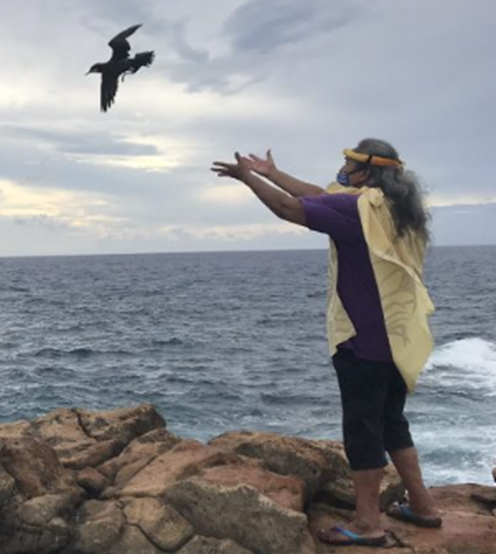KIUC’s electrical transmission and distribution system is largely composed of above ground wires that span around the island and deliver electricity to approximately 34,000 KIUC members. KIUC also maintains approximately 4,000 streetlights island wide. These KIUC facilities are known to adversely affect certain species protected by the federal Endangered Species Act and its state equivalent. For years, KIUC has worked collaboratively with U.S. Fish and Wildlife (USFWS) and the Hawaii Department of Land & Natural Resources, Division of Forestry and Wildlife (DOFAW) to address the complex issues concerning the potential adverse effects of utility lines and lights on state and federally listed threatened and endangered (T&E) species. Over the years, KIUC has implemented numerous measures that protect T&E species by reducing the adverse effects of our facilities and by improving survivability and recovery.

Some adverse effects are considered “take”. The take of species listed by the federal ESA and its state law equivalent, the Hawaiʻi Revised Statutes (HRS) Chapter 195D, incidental to otherwise lawful activities, is prohibited unless authorized. Non-federal entities must obtain that authorization via an incidental take permit (federal ITP) issued by the U.S. Fish and Wildlife Service (USFWS) and an incidental take license (state ITL) issued by the State of Hawai ̒i Department of Land and Natural Resources (DLNR), Division of Forestry and Wildlife (DOFAW) respectively. Applications for a federal incidental take permit and state incidental take license are supported by a Habitat Conservation Plan (HCP). An HCP describes the anticipated effects of the proposed taking of listed species; how those effects on the affected species will be avoided, minimized and mitigated; how the effects and the conservation strategy will be monitored; and how the HCP will be funded.
KIUC operated under its Short-Term Habitat Conservation Plan (STHCP), approved by USFWS in 2011, and associated incidental take permit from 2011 – 2016. The STHCP provided for the minimization and mitigation of adverse effects to three state and federally listed seabird species and focused on comprehensive monitoring for these species that would inform the development of a longer-term HCP. Since the HCP’s expiration in 2016, KIUC, in agreement with USFWS and DOFAW, has continued implementing those conservation measures. Starting in 2020, KIUC has expanded the conservation program to include many of the conservation measures in the longer-term HCP.
In collaboration with USFWS and DOFAW, KIUC has prepared a new draft HCP that will be published through the state’s Environmental Review Program website on January 23, 2023 for a 60 day public comment period. The deadline for comments on the draft HCP is March 24, 2023. From January 23rd to March 24th, the HCP can be viewed and instructions for submitting comments can be found at the following link.
The published draft HCP has been reviewed by USFWS and DOFAW, and will be reviewed by the state’s Endangered Species Recovery Committee (ESRC). A revised draft HCP will be released later in 2023 with an accompanying Environmental Impact Statement (EIS) as part of the federal review process and to comply with the National Environmental Policy Act and Hawai ̒i Environmental Policy Act.
The draft HCP is for a term of 50 years and requests the unavoidable incidental take through KIUC’s operations of the following state and federally T&E listed species.
- Three seabird species: Newell’s shearwater (ʻaʻo), Hawaiian petrel (ʻuaʻu) and the Band-rumped storm-petrel
- Five waterbird species: Hawaiian goose (nēnē), Hawaiian coot (ʻalae keʻokeʻo), Hawaiian duck (koloa maoli), Hawaiian stilt (aeʻo), and the Hawaiian gallinule (‘alae ‘ula)
- The green sea turtle (honu)
The draft HCP provides a comprehensive conservation strategy that will substantially reduce adverse effects of KIUC’s powerlines and nighttime lighting, and that will mitigate adverse effects that cannot be avoided.
Prior to approval of the draft HCP, KIUC’s current conservation efforts involve both minimization and mitigation. The reduction and avoidance of adverse effects is achieved through minimization measures such as shielding thousands of streetlights, shielding facility lighting, installation of reflective and LED bird diverters on powerlines, removal of static wire on overhead electrical transmission system, undergrounding and altering powerline configurations. An extensive, island wide powerline collision minimization plan was initiated in 2020 and will be completed by the end of 2023 greatly reducing adverse effects from powerline collisions.
Current mitigation measures implemented by KIUC protect and enhance seabird colony populations, and provide for the protection and recovery of impacted seabird species.
That work includes:
- Funding the implementation and ongoing operations of the Save Our Shearwaters program
- Seabird-colony management and monitoring at nine conservation sites
- Predator control at nine conservation sites
- Auditory surveys to quantify and track seabird colony populations
- Construction of predator exclusion fences at select colonies
An Environmental Impact Statement (EIS) is being prepared to meet requirements of both the National Environmental Policy Act (NEPA) and the Hawaiian Environmental Policy Act (HEPA). A Notice of Intent to prepare an EIS was published on June 8, 2022 for a 30-day public comment period. A public scoping meeting for the EIS was held in June 28, 2022.
Through the many years of conservation work, KIUC has developed strong partnerships with conservation organizations on Kauai including US Fish and Wildlife Service, Division of Forestry and Wildlife, the National Tropical Botanical Garden, the Kauai Endangered Seabird Recovery Project, Archipelago Research and Conservation, Hallux Ecosystem Restoration, Kōke'e Resource Conservation Program, Pacific Rim Conservation, Save our Shearwaters and the Hawaii Wildlife Center.
- News Releases
- Presentations
- December 8, 2022 - Endangered Species Recovery Committee
- For information on what you can do to reduce nighttime lighting impacts to seabirds, follow these links:
